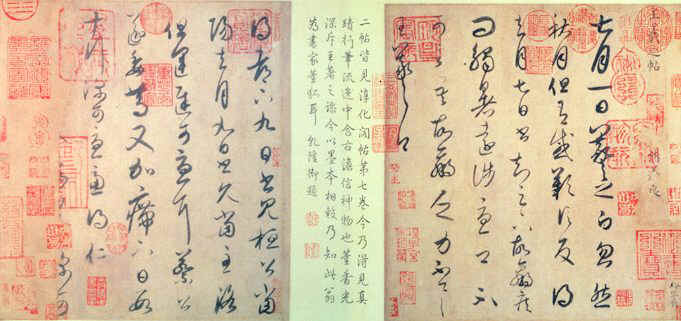Theories of Chinese Calligraphy
Once
I was shown two jade dragons. They looked almost exactly the same and were
sold at high prices in an international auction. Then I was asked which was the
original and which was the imitation. They both looked very, very beautiful and
shining. I did not know the answer. Then the man asked me which one had better
energy flow or connection. I still had no idea. Then he gave me a hint, “which
has more wholeness in design?” Then I was able to figure out.
In appreciating all Chinese arts, the first criterion will be the energy flow, i.e. Chi, life force, or connection of wholeness. If the stalk of a plant is drawn with many strokes and each stroke is "amended" several times, the plant will look like being torn apart and then glued back. But if the stalk is drawn with appropriate number of strokes or just one metaphysical stroke, the plant will look vivid or transcendental. ("Amending" or repeating a Chinese calligraphy stroke is considered a taboo and dishonest. Once a Chinese calligraphy stroke is done, it cannot be amended, enhanced, or fixed. This is very different from painting, Western calligraphy, or other forms of arts. Chinese place a strict rule on brush writing as it should come directly from one's mind and real skill. If an officer in China is found with amending a brush stroke in writing, he will be ridiculed and disrespected! An amended brush stroke can be easily told by experts because it shows evidences of inconsistent ink densities. )
Lotus
vividly and transcendentally painted with few strokes
The strokes of Chinese characters must have at least four quality ingredients: bone, flesh, muscle, and blood. Then what are the required features of a character’s structure? It must be in balance, stable, unbreakable, and beautiful. And what is the requirement of the whole work? That’s coherence. Coherence can be interpreted as having enough energy flow, no mismatch in details and connections of wholeness. Taken as a whole, a good Chinese calligraphy work should be like flowing out when viewed far away and with spirit and delicacy inside strong will when examined close by. When being appreciated, it will also be everlasting and loveable. If a work can pass all three tests, then it is a good one. The criteria can be summarized into three words: flowing, spirit, and everlasting.
There are many so-called Chinese calligraphers who lack techniques and depth trying to impress the audience with characters of super large sizes. As long as the delicacy, spirit, and will are still within each stroke, the size of characters is not a decisive factor to rate a Chinese calligraphy work. Merely large sizes are delusions to the public and disguise of one self and one's real skill. In fact, smaller characters require a highest level of precision and mind intensity. That is why there are very few Chinese calligraphers who specialize in Small Characters throughout every dynasty.
|
Emperor Tang Tai Zong used to appreciate and adore Wang Hsi-Chih’s works and could not get his hands off for hours. He wrote the following comments: “I examined all ancient and contemporary calligraphy works in very tiny details of ink nuances. I only find Wang Hsi-Chih as the most perfect calligrapher … His works look like mist surrounding, dews condensing, connecting as if not connecting … upright as if slanted.” |

A famous work of Wang Hsi-Chih that looks elegant, flowing, spirited, and loveable.